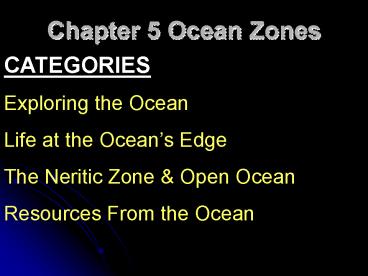Chapter 5 Ocean Zones - PowerPoint PPT Presentation
1 / 22
Title: Chapter 5 Ocean Zones
1
Chapter 5 Ocean Zones
CATEGORIES Exploring the Ocean Life at the
Oceans Edge The Neritic Zone Open
Ocean Resources From the Ocean
2
Exploring the Ocean
- The gently sloping, shallow ocean floor extending
out from the edge of a continent is know as the - Continental Shelf
- What are two reasons why people have explored the
oceans? - To gain scientific info., obtain food, conduct
trade, establish new settlements and gain fame.
HOME
3
Exploring the Ocean
- Why have scientists had to develop technology to
enable them to study the deep ocean floor? - Darkness, cold and extreme pressure
- How is sonar an indirect way of gathering data?
- Depths are not measured directly but are
calculated based on the timing of echoes.
HOME
4
Exploring the Ocean
- What is the smooth, nearly flat region of the
ocean floor called? - Abyssal plain
- What is a seamount?
- Mountains that are completely underwater.
HOME
5
Exploring the Ocean
- Which ocean floor feature makes up the deepest
parts of the ocean? - Trenches
- The high temperature pressure inside the Earth
cause some of the material in the mantle to form
a hot liquid called - Magma
HOME
6
Exploring the Ocean
HOME
- At the mid-ocean ridge, magma wells upward from
Earths - Mantle
- The thin, rocky, outer layer of Earth is called
the - Crust
7
Life at the Oceans Edge
- Some physical factors that determine where marine
organisms can live include - Salinity, water temp., light, dissolved gases,
nutrients and wave action. - Free-swimming animals that move throughout the
water column are called - Nekton
HOME
8
Life at the Oceans Edge
- Which organisms inhabit the ocean floor?
- Benthos
- Are Sharks plankton, nekton or benthos?
- Nekton
HOME
9
Life at the Oceans Edge
- Why are sharks nekton?
- They can swim freely throughout the water column.
- Where is the intertidal zone located?
- It stretches from the highest high-tide line on
land out to the point on the continental shelf
exposed by the lowest low-tide.
HOME
10
Life at the Oceans Edge
- A _______ is a coastal inlet or bay where fresh
water from a river mixes with salty ocean water. - Estuary
HOME
11
Life at the Oceans Edge
- What are the two types of coastal wetlands?
- Mangrove forests Salt marshes
HOME
12
Neritic Zone Open Ocean
- Coral reefs and kelp forests are usually found in
the - Neritic Zone
- What are two ways that nutrients may be supplied
to the neritic zone? - Washed into the ocean from land or brought from
the bottom by upwelling currents
HOME
13
Neritic Zone Open Ocean
- How can human activity impact a coral reef?
- Boat anchors, divers, making the water cloudy or
chemicals polluting the water.
HOME
14
Neritic Zone Open Ocean
- How can changes in water temperature clarity
affect coral reefs? - If the water is too warm the coral animal will
release the algae. If the water is too cloudy
the algae will die. Without algae the coral will
not grow and eventually die
15
Neritic Zone Open Ocean
- What is an atoll?
- It is a ring-shaped reef surrounding a shallow
lagoon. - Why do very few organisms live in the deep zone?
- Harsh conditions with very cold water, no light
and limited food supply.
HOME
16
Neritic Zone Open Ocean
- What is a hydrothermal vent?
- An area where ocean water sinks through cracks in
the ocean floor, is heated by magma rises
again. - How do hydrothermal vents support living things?
- By releasing chemical nutrients that bacteria use
to produce food.
HOME
17
Neritic Zone Open Ocean
- The surface zone is the only part of the open
ocean that receives enough _______ to support - Sunlight and growth of algae.
18
Resources from the Ocean
- What does overfishing cause?
- The amount of fish to decrease.
- The farming of saltwater and freshwater organisms
is called - Aquaculture
HOME
19
Resources from the Ocean
- What is the source of the oil gas deposits on
the ocean floor? - Formed from remain of living organisms
- How are fisheries naturally renewed each year?
- New fish are born, replacing the fish that are
caught.
HOME
20
Resources from the Ocean
- Most ocean pollution comes from
- Human Sources
- Name a nonliving resource found in the ocean.
- Fresh water from desalination, magnesium, gravel,
sand, shells, diamonds, gold, oil natural gas.
HOME
21
Resources from the Ocean
- Why cant each nation make its own laws regarding
ocean resources? - Different nations laws might conflict. No
nation owns the high seas.
HOME
22
Resources from the Ocean
- Why should nations cooperate?
- To protect the oceans
HOME































